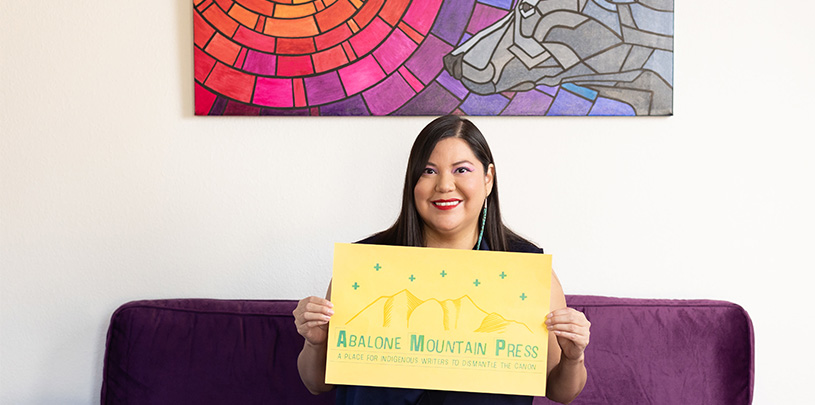
Guest post by Stacy Thacker
The Grand Canyon Trust is proud to partner with Change Labs to help entrepreneurs realize their dreams and build a strong, resilient, and culturally respectful economy across Native America.
In a downtown Phoenix office sits a Diné woman using her business to change how Indigenous writers are published and seen.
Amber McCrary, the owner and operator of Abalone Mountain Press, is giving the voice of Indigenous writers a safe space to grow. The purpose of McCrary’s press is to let Indigenous writers be their unique selves without having to cater to non-Indigenous editors and publishers.
“I feel like they are very much overlooked,” she said of Indigenous voices.
 ROSHAN SPOTTSVILLE
ROSHAN SPOTTSVILLE
McCrary wants to shine a light on the words that flow from Indigenous artists. Especially poets because McCrary feels there is a lot of beauty in Indigenous poetry that is going unseen.
“The press is fighting for these poems and for these Native books to be out there,” she said. ”Big presses only release one or two Native poets a year so I want to have a bigger platform for Native poets.”
McCrary, a poet herself, knows the struggle of being heard. It’s through her own experiences that she’s now able to help other writers.
“I started working more with Native writers and also with Native students when it came to teaching them poetry,” McCrary said. “I felt really inspired because I felt like there are so many Native writers that are such good poets out there. I felt like that was something that isn’t being recognized and that’s why I wanted to started my press specifically for Native writers.”
 ROSHAN SPOTTSVILLE
ROSHAN SPOTTSVILLE
She opened her office in downtown Phoenix in February of 2021 and learned a lot in her first year of operation. The small businesses that surround her have also been a big help and the owners have become mentors to her. And she even got some early success.
“The most successful part so far has been the Plants and Animals of Diné Bikeyah coloring book,” McCrary said. “A lot of people have been wanting that and some schools have ordered big bulks. It’s been fun working with the schools and knowing that students are getting them on the rez.”
The coloring book is written in Navajo and comes with four crayons labeled in the Navajo language. However, McCrary has also had another creative success. She really enjoys “zines,” or a homemade magazine. She recently collaborated with friends and Native artists to create “Portals of Indigenous Futurism.” The Zine includes short stories, poems, comics and collages. Abalone Mountain Press also offers a podcast that focuses on artists’ creative perspectives, tips on writing and other topics such as life lessons and perspectives.
But along with the success comes challenges. A big one for McCrary is getting products out quickly.
“Books usually take a longer time to get into a shop,” she said. “Usually I’m waiting six months to a year before a book is going to be in the shop.”
That’s because the process to publish is a long road. The manuscript has to be submitted and the editing process takes about six months at the earliest, she said.
“I think patience is one of the biggest challenges when it comes to the editing process for the books,” she said.
As much as she’d like to see the products get on the shelf faster, she makes sure every piece gets the attention it deserves.
 ROSHAN SPOTTSVILLE
ROSHAN SPOTTSVILLE
Working with other Indigenous writers keeps McCrary’s creativity flowing.
“I’m inspired by other poets and that’s what keeps me going, reading other stories by other poets that I enjoy or even fiction or nonfiction writers,” she said.
McCrary said she was always called an artist but she denied it because it didn’t fit her definition of an artist.
“I always wished that I was artistic but I don’t know how to draw and I don’t know how to sing. Those were the two biggest things I always wanted to be. I didn’t have either of those skills so I think I never really took myself seriously as an artist or even thought I was an artist,” she said.
When she finally accepted her talent as a poet and writer, her world opened up and it quickly changed. And now she chooses to help other Native artists harness their talent.
This blog is reprinted with permission from Change Labs. Read the original post and learn more ›
First-generation jeweler Thomas Deel is back at his jeweler's bench crafting statement pieces out of silver, turquoise, coral, and gold.
Read MoreSummer and LaMandez Brown knew there weren't a lot of jobs on the Navajo reservation. So they made their own.
Read MoreMarisa Mike, a Diné fashion designer, combines traditional styles with contemporary twists in her line of special-occasion wear.
Read More